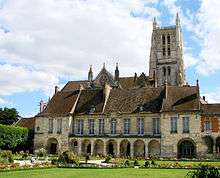Meaux
Meaux is a city of about 54,000 people (2014) in Île-de-France.
Understand
Inhabitants of Meaux are called Meldois. Both names Meaux and Meldois originated with the Meldi, the Latin name of the original Gaulish tribe who occupied this area of the valley of the Marne river.
Historical buildings and monuments in Meaux are mainly in the old city, inside the old defensive walls, still nowadays partially kept thanks to an important segment of the original surrounding wall from the Gallo-Roman period. A meander of the Marne river divides the old city into the North Quarter (called among the Meldois as the Cathedral Quarter) and the South Quarter (known among the locals as the Market Quarter).
Get in
Meaux is served by Meaux station on the Transilien Paris – Est suburban rail line and on several national rail lines.
Beside the Meaux rail station is the main bus station in the city, with more than 30 bus lines serving the whole eastern Paris metropolitan area.
Get around
See

- In the North Quarter there is the Meaux Cathedral, the episcopal palace and its gardens (outlining the shape of a bishop's mitre), the old seat of the chapter (le vieux chapitre), part of the defensive walls, some keeps and towers, and the archaeological remains of the sanctuary of La Bauve, all-embracing the Gaulish period (4th, 3rd and 1st centuries BC), the era of the early Roman Empire, and the early Christian Era and subsequent centuries.
- The South Quarter of the old city mainly includes the historic covered market and the Canal Cornillon, built during the Middle Ages, in the year 1235. Centuries later, in 1806, during the Napoleonic era, was built the Canal de l'Ourcq, destined to the inland navigation when the Marne river is not navigable because of temporary sandbanks.
- Every summer for more than 30 years, during several weekends per summer, a show is played by stage actors in the esplanade situated between the cathedral and the episcopal palace: the Spectacle historique ("History show"). The show represents the history of Meaux all along the Middle Ages and the Renaissance, and also during World War I (the German advance had been halted at Meaux in 1914 during the First Battle of the Marne).
Do
Several festivals and concerts are celebrated in Meaux, venues for live music like the Music Festival "Musik'elles" (usually at the end of every summer).
Buy
Eat
Meaux is nowadays mainly known for Brie de Meaux (a variety of Brie cheese) and the local variety of mustard. Following the official administrative French AOC there are two designations of Brie de Meaux: Brie de Meaux fermier ("farm Brie de Meaux", made out of the milk from the cows of a single unique producer) and Brie de Meaux laitier (laitier, that is from the French lait, "milk", which designates here an agreement, a mixture of the milk of different producers). The Moutarde de Meaux ("Meaux Mustard") recipe is since the 18th century a label commercially owned by the Pommery company and is nowadays derived not only in its traditional well known form but also in a variety of new different ingredient combinations: Honey Mustard, Green Pepper Mustard, Moutarde Royale (that latter including Cognac in its composition) etc.
Drink
Sleep
- 🌍 Museum of the Great War Pays de Meaux (Musee de la grande guerre Pays de Meaux), Rue Lazare Ponticelli, ☎ +33 1 60 32 14 18. W-M 09:30-18:00; closed 1 May, 25 Dec, 1 Jan, 8-19 Jan. More than 65 000 items make up this collection which explores the conflict, and the technical and military plans from a human and societal point of view. It has full uniforms from the majority of the warring countries, weaponry and artillery, heavy machinery, objects from daily life on the front line and back home, many documents and a great range of artwork. Adult €10, veterans, students and seniors €7, under 26 €5.
- The Musée Bossuet, in the episcopal palace, is the art and history museum of Meaux.